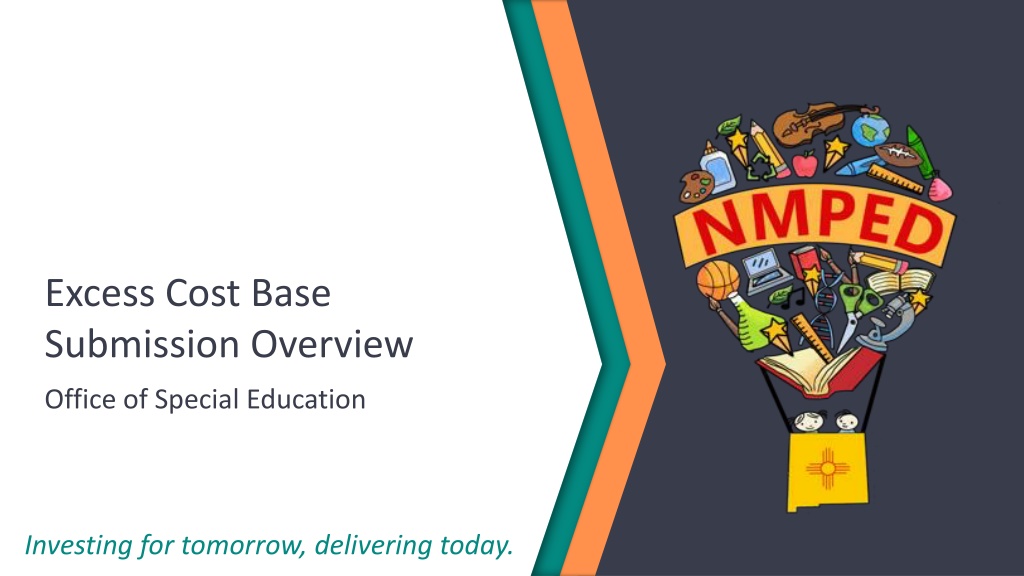Understanding Excess Costs in Special Education
Excess costs in special education refer to additional expenses incurred by Local Educational Agencies to provide services to children with disabilities. These costs go beyond the average per-student expenditure on general education. The calculation of excess costs ensures that federal IDEA Part B funds are used appropriately to support children with disabilities without supplanting existing funding sources. Maintaining a balance between MOE requirements and excess cost calculations is crucial to preserving special education funding integrity.
Download Presentation

Please find below an Image/Link to download the presentation.
The content on the website is provided AS IS for your information and personal use only. It may not be sold, licensed, or shared on other websites without obtaining consent from the author. Download presentation by click this link. If you encounter any issues during the download, it is possible that the publisher has removed the file from their server.
E N D
Presentation Transcript
Excess Cost Base Submission Overview Office of Special Education Investing for tomorrow, delivering today.
Agenda Excess Cost Definition Relation to MOE and connection to Supplanting Excess Cost Submission Types The Excess Cost Submission Process in SharePoint 2 Investing for tomorrow, delivering today.
Excess Cost Definition Definition of Excess Cost Excess Cost refers to the additional costs incurred by Local Educational Agencies (LEAs) for providing special education and related services to children with disabilities, over and above the average annual per-student expenditure from all sources (local, state, and federal) on general education students. Essentially, it represents the extra amount LEAs need to spend to ensure that children with disabilities receive the appropriate education and services they are entitled to under IDEA (Individuals with Disabilities Education Act). The purpose of calculating excess costs is to ensure that federal IDEA Part B funds are used specifically for these additional expenses, rather than replacing existing funding sources. 3 Investing for tomorrow, delivering today.
Excess Costs vs. MOE MOE ensures consistent financial support: The MOE requirements prevent LEAs and states from reducing their own spending on special education from year to year, thus maintaining a steady level of financial effort. Excess Cost Calculation ensures IDEA funds cover additional costs: Before IDEA Part B funds can be used, LEAs must demonstrate they have spent a minimum average amount from local/state funds on general education costs for students with disabilities. Prevents Supplanting: Together, MOE and excess cost calculations help ensure that IDEA Part B funds are used as intended to provide additional support for special education rather than replacing existing funding sources. These processes work together to ensure that special education funding is maintained and appropriately augmented with federal funds, thereby preventing the improper use of federal funds to replace local and state investments in special education. 4 Investing for tomorrow, delivering today.
Connection to Supplanting Supplanting refers to using federal funds to replace (supplant) state, local, or other federal funds, which is generally prohibited under IDEA: Supplanting Rule: IDEA Part B funds must be used to supplement and increase the level of funding for special education and related services, not replace existing funding sources. This means federal funds should add to the current funding levels rather than displace them. 5 Investing for tomorrow, delivering today.
Excess Cost Submissions The New Mexico Public Education Office of Special Education will collect excess cost submissions twice each year: Base Submission Collected in the Spring Compliance Submission Collected in the Fall 6 Investing for tomorrow, delivering today.
Excess Cost Types Excess Cost Base Submission (Spring): These figures are based on budgeted amounts. May include projections derived from historical data. The United States Department of Education requires each LEA to submit figures separated between elementary and secondary education levels. This calculation is to establish eligibility for IDEA B funds by assuring LEAs have estimate of costs from state and local funds. Excess Cost Compliance Submission (Fall): These figures are based on the actual expenditures finalized from the prior fiscal year. The United States Department of Education requires each LEA to submit figures separated between elementary and secondary education levels. 7 Investing for tomorrow, delivering today.
Excess Cost Site Submission Once logged in to the SharePoint, find your LEA name from the list and click on the Edit button. Access: Must have a STARS/Nova login If you do not have a STARS/NOVA username, please contact LEA NOVA coordinator to gain access. For access to the Excess Cost site contact: Mahesh Reddy-Erri mahesh.reddy@ped.nm.gov 8 Investing for tomorrow, delivering today.
Separating Costs The United States Department of Education requires the Excess Cost Submission (Base and Compliance) to be submitted separated by Elementary and Secondary grade levels. Base: Budgets are not submitted by school site. You may use your membership to determine a ratio, and use that ratio to determine budgeted numbers. Compliance: Actuals are collected by school site, use exact figures based on your submission. 9 Investing for tomorrow, delivering today.
Excess Cost Site Submission There are two submission fields in the Excess Cost Site, one for Base and one for Compliance. Base will be collected in the Spring and Compliance will be collected in the Spring. Base Submission(Spring) Compliance Submission (Fall) 10 Investing for tomorrow, delivering today.
Sources [Supplanting](https://sites.ed.gov/idea/regs/b/b/300.164/a) [MOE](https://www2.ed.gov/policy/speced/guid/idea/idea-edjobs-guidance.pdf) [Excess Costs Calculation](https://sites.ed.gov/idea/regs/b/appendix-a) 11 Investing for tomorrow, delivering today.

 undefined
undefined































